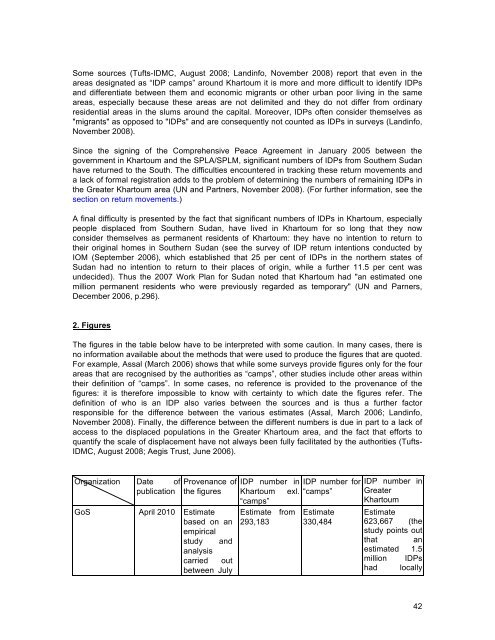SUDAN: Durable solutions elusive as southern IDPs return and ...
SUDAN: Durable solutions elusive as southern IDPs return and ...
SUDAN: Durable solutions elusive as southern IDPs return and ...
Create successful ePaper yourself
Turn your PDF publications into a flip-book with our unique Google optimized e-Paper software.
Some sources (Tufts-IDMC, August 2008; L<strong>and</strong>info, November 2008) report that even in the<br />
are<strong>as</strong> designated <strong>as</strong> “IDP camps” around Khartoum it is more <strong>and</strong> more difficult to identify <strong>IDPs</strong><br />
<strong>and</strong> differentiate between them <strong>and</strong> economic migrants or other urban poor living in the same<br />
are<strong>as</strong>, especially because these are<strong>as</strong> are not delimited <strong>and</strong> they do not differ from ordinary<br />
residential are<strong>as</strong> in the slums around the capital. Moreover, <strong>IDPs</strong> often consider themselves <strong>as</strong><br />
"migrants" <strong>as</strong> opposed to "<strong>IDPs</strong>" <strong>and</strong> are consequently not counted <strong>as</strong> <strong>IDPs</strong> in surveys (L<strong>and</strong>info,<br />
November 2008).<br />
Since the signing of the Comprehensive Peace Agreement in January 2005 between the<br />
government in Khartoum <strong>and</strong> the SPLA/SPLM, significant numbers of <strong>IDPs</strong> from Southern Sudan<br />
have <strong>return</strong>ed to the South. The difficulties encountered in tracking these <strong>return</strong> movements <strong>and</strong><br />
a lack of formal registration adds to the problem of determining the numbers of remaining <strong>IDPs</strong> in<br />
the Greater Khartoum area (UN <strong>and</strong> Partners, November 2008). (For further information, see the<br />
section on <strong>return</strong> movements.)<br />
A final difficulty is presented by the fact that significant numbers of <strong>IDPs</strong> in Khartoum, especially<br />
people displaced from Southern Sudan, have lived in Khartoum for so long that they now<br />
consider themselves <strong>as</strong> permanent residents of Khartoum: they have no intention to <strong>return</strong> to<br />
their original homes in Southern Sudan (see the survey of IDP <strong>return</strong> intentions conducted by<br />
IOM (September 2006), which established that 25 per cent of <strong>IDPs</strong> in the northern states of<br />
Sudan had no intention to <strong>return</strong> to their places of origin, while a further 11.5 per cent w<strong>as</strong><br />
undecided). Thus the 2007 Work Plan for Sudan noted that Khartoum had "an estimated one<br />
million permanent residents who were previously regarded <strong>as</strong> temporary" (UN <strong>and</strong> Parners,<br />
December 2006, p.296).<br />
2. Figures<br />
The figures in the table below have to be interpreted with some caution. In many c<strong>as</strong>es, there is<br />
no information available about the methods that were used to produce the figures that are quoted.<br />
For example, Assal (March 2006) shows that while some surveys provide figures only for the four<br />
are<strong>as</strong> that are recognised by the authorities <strong>as</strong> “camps”, other studies include other are<strong>as</strong> within<br />
their definition of “camps”. In some c<strong>as</strong>es, no reference is provided to the provenance of the<br />
figures: it is therefore impossible to know with certainty to which date the figures refer. The<br />
definition of who is an IDP also varies between the sources <strong>and</strong> is thus a further factor<br />
responsible for the difference between the various estimates (Assal, March 2006; L<strong>and</strong>info,<br />
November 2008). Finally, the difference between the different numbers is due in part to a lack of<br />
access to the displaced populations in the Greater Khartoum area, <strong>and</strong> the fact that efforts to<br />
quantify the scale of displacement have not always been fully facilitated by the authorities (Tufts-<br />
IDMC, August 2008; Aegis Trust, June 2006).<br />
Organization Date of<br />
publication<br />
Provenance of<br />
the figures<br />
GoS April 2010 Estimate<br />
b<strong>as</strong>ed on an<br />
empirical<br />
study <strong>and</strong><br />
analysis<br />
carried out<br />
between July<br />
IDP number in<br />
Khartoum exl.<br />
“camps”<br />
Estimate from<br />
293,183<br />
IDP number for<br />
“camps”<br />
Estimate<br />
330,484<br />
IDP number in<br />
Greater<br />
Khartoum<br />
Estimate<br />
623,667 (the<br />
study points out<br />
that an<br />
estimated 1.5<br />
million <strong>IDPs</strong><br />
had locally<br />
42
















